Miałem pewne wątpliwości co do tej podstawowej, ale ważnej kwestii, więc postanowiłem uczyć się na przykładzie.
Stwórzmy tabelę testową master z dwiema kolumnami, con_id z unikalnym ograniczeniem i ind_id indeksowane według unikalnego indeksu.
create table master (
con_id integer unique,
ind_id integer
);
create unique index master_unique_idx on master (ind_id);
Table "public.master"
Column | Type | Modifiers
--------+---------+-----------
con_id | integer |
ind_id | integer |
Indexes:
"master_con_id_key" UNIQUE CONSTRAINT, btree (con_id)
"master_unique_idx" UNIQUE, btree (ind_id)
W opisie tabeli (\d w psql) możesz odróżnić unikalne ograniczenie od unikalnego indeksu.
Wyjątkowość
Sprawdźmy unikalność, na wszelki wypadek.
test=# insert into master values (0, 0);
INSERT 0 1
test=# insert into master values (0, 1);
ERROR: duplicate key value violates unique constraint "master_con_id_key"
DETAIL: Key (con_id)=(0) already exists.
test=# insert into master values (1, 0);
ERROR: duplicate key value violates unique constraint "master_unique_idx"
DETAIL: Key (ind_id)=(0) already exists.
test=#
Działa zgodnie z oczekiwaniami!
Klucze obce
Teraz zdefiniujemy szczegóły tabela z dwoma kluczami obcymi odnoszącymi się do naszych dwóch kolumn w master .
create table detail (
con_id integer,
ind_id integer,
constraint detail_fk1 foreign key (con_id) references master(con_id),
constraint detail_fk2 foreign key (ind_id) references master(ind_id)
);
Table "public.detail"
Column | Type | Modifiers
--------+---------+-----------
con_id | integer |
ind_id | integer |
Foreign-key constraints:
"detail_fk1" FOREIGN KEY (con_id) REFERENCES master(con_id)
"detail_fk2" FOREIGN KEY (ind_id) REFERENCES master(ind_id)
Cóż, żadnych błędów. Upewnijmy się, że to działa.
test=# insert into detail values (0, 0);
INSERT 0 1
test=# insert into detail values (1, 0);
ERROR: insert or update on table "detail" violates foreign key constraint "detail_fk1"
DETAIL: Key (con_id)=(1) is not present in table "master".
test=# insert into detail values (0, 1);
ERROR: insert or update on table "detail" violates foreign key constraint "detail_fk2"
DETAIL: Key (ind_id)=(1) is not present in table "master".
test=#
Do obu kolumn można się odwoływać w kluczach obcych.
Ograniczenie za pomocą indeksu
Możesz dodać ograniczenie tabeli, używając istniejącego unikalnego indeksu.
alter table master add constraint master_ind_id_key unique using index master_unique_idx;
Table "public.master"
Column | Type | Modifiers
--------+---------+-----------
con_id | integer |
ind_id | integer |
Indexes:
"master_con_id_key" UNIQUE CONSTRAINT, btree (con_id)
"master_ind_id_key" UNIQUE CONSTRAINT, btree (ind_id)
Referenced by:
TABLE "detail" CONSTRAINT "detail_fk1" FOREIGN KEY (con_id) REFERENCES master(con_id)
TABLE "detail" CONSTRAINT "detail_fk2" FOREIGN KEY (ind_id) REFERENCES master(ind_id)
Teraz nie ma różnicy między opisem ograniczeń kolumn.
Indeksy częściowe
W deklaracji ograniczenia tabeli nie można tworzyć indeksów częściowych. Pochodzi bezpośrednio z definicji create table ... .W unikalnej deklaracji indeksu możesz ustawić WHERE clause aby utworzyć indeks częściowy. Możesz również utworzyć indeks na wyrażeniu (nie tylko na kolumnie) i zdefiniować kilka innych parametrów (sortowanie, porządek sortowania, umieszczanie wartości NULL).
nie możesz dodaj ograniczenie tabeli za pomocą indeksu częściowego.
alter table master add column part_id integer;
create unique index master_partial_idx on master (part_id) where part_id is not null;
alter table master add constraint master_part_id_key unique using index master_partial_idx;
ERROR: "master_partial_idx" is a partial index
LINE 1: alter table master add constraint master_part_id_key unique ...
^
DETAIL: Cannot create a primary key or unique constraint using such an index.




